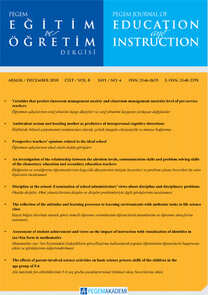Effectiveness of Code-Switching in Language Classroom in India at Primary Level: A Case of L2 Teachers’ Perspectives
Effectiveness of Code-Switching in Language Classroom in India at Primary Level: A Case of L2 Teachers’ Perspectives
___
- Ajmal, M., & Kumar, T. (2020). Using DIALANG in assessing foreign language proficiency: The interface between learning and assessment. Asian ESP Journal. 16 (2.2), 335 - 362.
- Benyo, A. & Kumar, T. (2020). An analysis of Indian EFL learners’ listening comprehension errors. Asian ESP Journal. 16(5.2), 69-85.
- Boztepe, E. (2003). Issues in code-switching: competing theories and models. Studies in Applied Linguistics and TESOL, 3(2). Dendup, P. (2020). Code-Switching in the Classroom: The Perspectives of Bhutanese Teachers. International Journal of Linguistics and Translation Studies, 1(3), 47-57.
- Garrett, P. (2010). Attitudes to Language. Cambridge University Press.
- Goodman, D. (2006). Language Study in Teacher Education: Exploring the Language in Language Arts. Language Arts, 84(2), 145-156.
- Gulzar, M. A. (2010). Code-switching: Awareness about its utility in bilingual classrooms. Bulletin of Education and Research, 32(2), 23-44.
- Hakuta, K. (1986). Mirror of language. The debate on bilingualism. Basic Books, Inc., 10 East 53rd Street, New York, NY 10022.
- Kumar, T. (2020a). Assessing language need and proficiency of English graduates of Prince Sattam Bin Abdulaziz University for designing pre-placement training and workshops. Asian ErtyreedeefbnvcSP Journal. 16(4), 153-168.
- Kumar, T. (2020 b). Impact of motivation and group cohesion in EFL classrooms at Prince Sattam Bin Abdulaziz University, KSA. Asian EFL Journal. 27(4.4), 116-131.
- Kumar, T. (2021). ‘Desire to learn, learn to shine’: Idolizing motivation in enhancing speaking skill among L2 learners. Cypriot Journal of Educational Science. 16(1), 411-422. https://doi.org/10.18844/ cjes.v16i1.5542
- Nesamalar, Saratha & Teh (1995). Code Switching in the Teaching of English as a Second Language to Secondary School Students. Malaysian Journal of ELT Research ISSN: 1511-8002 Vol. 6.
- Nesamalar, et al. (1995). Code switching in the teaching of English as a second language to secondary school students. Malaysian Journal of ELT Research. Vol. 6.
- Ovando, Collier and Combs (2003). Code Switching in the Teaching of English as a Second Language to Secondary School Students. Malaysian Journal of ELT Research , Vol. 6.
- Poplack, S. (2001). Code-switching (linguistic). International encyclopaedia of the social and behavioral sciences, 12, 2062-2065.
- Ryan, E. B., & Giles, H. (Eds.) (1982). Attitudes towards Language Variation: Social and Applied Contexts (pp. 1-19). London: Edward Arnold.
- Shartiely, N. E. (2013). Discourse strategies of lecturers in higher education classroom interaction: a case at the University Dar Es Salaam, Tanzania (Doctoral dissertation, Stellenbosch: Stellenbosch University).
- Ta ha , T. A . (20 08). L a ng uage a lter nat ion i n u n iversit y classrooms. Journal of Instructional Psychology, 35(4), 336- 346. Wheeler, R. S., & Swords, R. (2010). Code-switching lessons: Grammar strategies for linguistically diverse writers: Grades 3-6. Firsthand Heinemann.
- Willis (1996). Code Switching in the Teaching of English as a Second Language to Secondary School Students. Malaysian Journal of ELT Research ISSN: 1511-8002, Vol. 6.
- ISSN: 2146-0655
- Yayın Aralığı: 4
- Başlangıç: 2011
- Yayıncı: Pegem Akademi Yayıncılık Eğitim Danışmanlık Hizmetleri Tic. Ltd. Şti.
Ahed Hani ALMSAİDEN, Taha Ali HUSSEİN
Does Problem-Based Learning Enhances Metacognitive Awareness of Economics Students?
Cipto WARDOYO, Bagus Shandy NARMADİTYA, Agus WİBOWO
Development and implementation of mathematics attitudes scale for the primary and secondary students
Mehmet GÜLBURNU, Kenan YILDIRIM
Hanifah MAHAT, Saiyidatina B. NORKHAİDİ, Mohmadisa HASHİM, Nasir NAYAN, Yazid SALEH, Nurul H. L. ABDULLAH, Nur Hidayah BAHARUDİN, Nurakma JAMHARİ
In-demand Soft Skills and Employability during and Post COVID-19: Evidence from EFL Teachers
Ahmad A.S. TABİEH, Hiba Y ABUZAGHA, Kazim A. Al GHOU
Foreign Language Anxiety and Gifted Students in Turkey
Fine Reffiane, Sudarmin, Sigit Saptono, Wiyanto
Development of an instrument of assertive communication scale based on Yogyakarta Cultural Value
Andi Mappiare, M.Ramli, Ahmad Taufiq, Nur Hidayah, Sunaryono, Muya Barida
